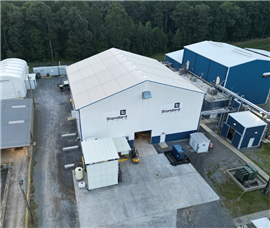Read this article in 中文 Français Deutsch Italiano Português Español
Billions for batteries: US Energy funding major battery manufacturing construction
24 September 2024
 Render of Ascend Elements’ Apex 1 pCAM battery manufacturing facility in Kentucky, US. (Image courtesy Ascend Elements)
Render of Ascend Elements’ Apex 1 pCAM battery manufacturing facility in Kentucky, US. (Image courtesy Ascend Elements)
The US Department of Energy (DOE) announced a new list of 25 selectees for its Battery Materials Processing and Battery Manufacturing and Recycling grant programmes, two funding mechanisms worth an overall US$16 billion allocated to develop battery manufacturing, processing and recycling across the country.
The most recent selected projects (‘round two’) are set to receive more than $3 billion from the fund. Earlier this year, the DOE awarded $1.82 billion to 14 projects as part of ‘round one’.
With billions still left to spend, the announcement means construction work on large-scale manufacturing facilities should be readily available, as projects are spread across the US. According to the government, the investment is meant to bolster and support domestic electric vehicle (EV) and energy storage system (ESS) markets.
The DOE said round-one schemes emphasise building and expansion of commercial-scale facilities to extract lithium, graphite and other needed materials for battery and battery-component manufacturing. Round-one grants have officially been awarded and some are in the construction phase (and one complete), according to DOE as of 23 September.
Round-two projects are generally designed to boost battery production nationwide and demonstrate new approaches to component manufacturing and material recycling. While round-one grants have officially awarded, the selectees in round two still require final federal approval.
Here’s a look at the four biggest awards between round-one awardees and round-two selectees.
Kentucky ‘Apex’ scheme awarded nearly $500 million
Project Details
Names: Apex – Integrated Sustainable Battery Precursor & Integrated Sustainable Battery Active Material Production Plant
Applicant: Ascend Elements
Location: Hopkinsville, Kentucky, US
Federal cost share: $480 million ($316 million & $164 million)
Segment: Materials separation & processing (cathode minerals) & component manufacturing
Contractors: Turner Construction and Kokosing Industrial
Almost $500 million was awarded to two projects at the same site.
Representing two of the three largest grants among all 14 awarded plans is the Apex project by Massachusetts, US-based Ascend Elements, an independent advanced battery manufacturer.
The two schemes are named Integrated Sustainable Battery Precursor (ISBP) and Integrated Sustainable Battery Active Material Production Plant (ISBAMPP).
 Construction crews work on the Apex 1 building in Kentucky, US, for Ascend Elements. (Image courtesy Ascend Elements)
Construction crews work on the Apex 1 building in Kentucky, US, for Ascend Elements. (Image courtesy Ascend Elements)
According to DOE, the Apex ISBP project will establish a 315,000 sq ft (29,264m2) industrial-scale facility named ‘Apex 1’ on a 140-acre (57-hectare) campus to produce “sustainable, low-cost precursor cathode materials by integrating the separation of critical cathode materials from spent lithium-ion batteries (LiBs) with the production of both precursor cathode active materials (pCAM) and metal salts to support domestic production of cathode active material (CAM).”
The CAM will be used in LiBs for EVs and ESS with an expectation that the factory will produce materials for up to 750,000 EVs annually.
The ISBAMPP plan will construct a complimentary CAM plant at the same location.
The facility will consist of multiple manufacturing buildings and, when complete, will have a capacity to produce 13,608 tonnes-per-year of battery-grade metal salts and 18,144 tonnes-per-year of advanced pCAM, said DOE.
Construction of the CAM plant will consist of a manufacturing building and the processing equipment necessary to convert precursor materials into CAM.
When complete, the plant is expected to have CAM manufacturing capacity of 20,000 metric tons per year.
DOE also expects the project to generate more than $4.4 billion in total economic impact during the projected three-year construction period and over the first decade of operation at the Apex site. The Apex site is scheduled to open in 2025.
Brine for battery production selected for $450 million
The two selectees allocated the largest amount of funding will both build infrastructure to support facilities using brine in lithium battery production, and each are scheduled to received $225 million as part of the grant programmes.
Project Details
Name: Commercial Domestic Production of Lithium Carbonate from the Smackover Formation Brines in Southern Arkansas Using Direct Lithium Extraction Technology
Applicant: SWA Lithium (Standard Lithium and Equinor JV)
Location: Lewisville, Arkansas, US
Federal cost share: $225 million
Segment: Raw materials
Design & engineering: Ausenco Engineering Canada
The SWA Lithium project is expected to be one of the world’s first commercial scale DLE (Direct Lithium Extraction) projects, the DOE said. It’s site will use locally sourced brine in lithium carbonate production.
The DOE said, at full capacity, the project has the potential to produce up to 45,000 tonnes-per-annum of battery-quality lithium carbonate over a minimum 20-year operating life. SWA includes some of the highest reported lithium brine concentrations in North America with a maximum lithium grade of 597mg/L and an average of 437mg/L.
A joint venture between Canada-based Equinor – a technology and lithium development firm – and Standard Lithium – a US-based chemical company focused on brine resources – the pair are planning multiple facilities on a 118-acre site in western Kentucky, US.
SWA Lithium selected Ausenco Engineering Canada to provide feasibility study and front-end engineering and design services.
Project Details
Name: Commercial Scale Facility for Lithium Extraction from Domestic Brine Resources
Applicant: TerraVolta Resources
Location: Texarkana region (US states of Texas and Arkansas)
Federal cost share: $225 million
Segment: Raw materials
Much like the SWA Lithium project, the TerraVolta Resources’ plan near the Texas and Arkansas border involves using domestic brine for battery-grade lithium carbonate equivalent (LCE).
TerraVolta is a Texas-based minerals exploration, production and supply company.
“The project objective is to design, build, and operate a commercial-scale lithium extraction and refining facility to produce battery-grade lithium from domestic brine resources,” explained DOE of the construction work.
 An existing Standard Lithium DLE facility in Arkansas, US. (Image: Standard Lithium)
An existing Standard Lithium DLE facility in Arkansas, US. (Image: Standard Lithium)
Once complete, the facility is expected to have an annual production capacity of 25,000 tonnes of LCE, which could power up to 500,000 EVs and eliminate an estimated 2.2 million metric tons of CO2 annually.
The facility will include refining capabilities to convert the extracted lithium chloride (LiCl) from brine into battery-grade lithium carbonate (Li2CO3), added the DOE.
Details for construction activity were not available.
STAY CONNECTED


Receive the information you need when you need it through our world-leading magazines, newsletters and daily briefings.
CONNECT WITH THE TEAM











